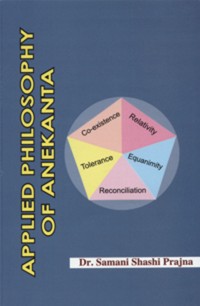The theory of Anekānta with its corollaries of nayavāda and syādvāda serves a complete and exhaustive philosophy of life. Anekānta is the heart of Jain metaphysics and nayavāda and syādvāda are its main arteries or to use a happier metaphor, the bird of anekāntavāda flies on its two wings of nayavāda and syādvāda in the words of Y.J. Padmarajiah.[1] So far as the relationship of three theories is concerned, all these are inter-connected. The precedent is the result of the antecedent one. In the absence of the concept of naya, the theory of anekānta couldn't have emerged. It is naya on the basis of which,the theory of anekānta came into being.[2] Syādvāda came into being when the question of logical expression of innumerable or infinite modifications and attributes of reality arose.[3]
Anekānta is a form of knowledge and anekāntika substance is the object of knowledge. The basis of anekānta is the nature of reality (sat) or substance. The nature of the substance in itself is permanent and temporary. It does not make any difference, if it is known by an ordinary man or an omniscient. The only difference is that a common man knows it through the sensuous knowledge whereas the omniscient knows it through the direct knowledge. The theory of anekānta is of universal application. Substance cannot exist without mode; therefore it applies to substance; mode cannot exist without substance; therefore it applies to mode. The transcendental existence and empirical existence are not absolutely separate in the Jain philosophy.[4] The mode is empirical existence and the substance is transcendental existence; but they are inseparably joined together. Both of them are two aspects of the same existence and therefore, they cannot be conceived of as absolutely independent.
If existence is to be propounded even by an omniscient, he will have to use syādvāda and saptabhaṅgī as similar is the case with an ordinary man. When substance in itself is permanent and temporary, how can the omniscient express it in absolute terms? He will have to use the language of syādvāda. For example, substance is relatively (i.e. with respect to a particular point of view) permanent and relatively temporary. So the acceptance of truth having multiple facets, partial perception of truth due to limitations of the observer, incomplete description of truth due to limitations of expression, and recognizing the equal possibility of different viewpoints to be true is in brief, is the theory of anekāntavāda. This theory spontaneously drives a Jaina, away from extremism, radicalism, and fanaticism. It is discussed in the present chapter, how anekāntavāda (the theory of non-absolutism), manifests itself as the most consistent form of realism in Indian philosophy. It would be contextually relevant to briefly touch upon the meaning of anekānta, the need of anekānta and theinter-relation of anekāntavāda, nayavāda and syādvāda, which together reveal the functional dynamics of anekāntavāda.
 Dr. Samani Shashi Pragya
Dr. Samani Shashi Pragya

